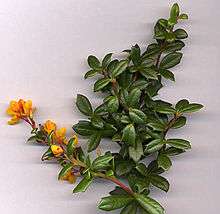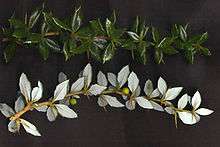Berberis
| Berberis | |
|---|---|
 | |
| Berberis darwinii shoot with flowers | |
 | |
| Berberis thunbergii shoot with fruit | |
| Scientific classification | |
| Kingdom: | Plantae |
| (unranked): | Angiosperms |
| (unranked): | Eudicots |
| Order: | Ranunculales |
| Family: | Berberidaceae |
| Genus: | Berberis L. |
| Species | |
Berberis (/ˈbɜːrbərɪs/) is a large genus of deciduous and evergreen shrubs from 1–5 m (3.3–16.4 ft) tall found throughout the temperate and subtropical regions of the world (apart from Australia). Species diversity is greatest in South America, Africa and Asia; Europe and North America have native species as well. The most well-known Berberis species is the European barberry, Berberis vulgaris, which is common in Europe, North Africa, the Middle East, and central Asia. Many of the species have spines on the shoots and along the margins of the leaves.[1][2]
Description
The genus Berberis has dimorphic shoots: long shoots which form the structure of the plant, and short shoots only 1–2 mm (0.039–0.079 in) long. The leaves on long shoots are non-photosynthetic, developed into one to three or more spines[3]:96 3–30 mm (0.12–1.18 in) long. The bud in the axil of each thorn-leaf then develops a short shoot with several normal, photosynthetic leaves. These leaves are 1–10 cm (0.39–3.94 in) long, simple, and either entire, or with spiny margins. Only on young seedlings do leaves develop on the long shoots, with the adult foliage style developing after the young plant is 1–2 years old.
Many deciduous species, such as Berberis thunbergii or B. vulgaris, are noted for their attractive pink or red autumn color. In some evergreen species from China, such as B. candidula or B. verruculosa, the leaves are brilliant white beneath, a feature valued horticulturally. Some horticultural variants of B. thunbergii have dark red to violet foliage.
The flowers are produced singly or in racemes of up to 20 on a single flower-head. They are yellow or orange, 3–6 mm (0.12–0.24 in) long, with six sepals and six petals in alternating whorls of three, the sepals usually colored like the petals. The fruit is a small berry 5–15 mm (0.20–0.59 in) long, ripening red or dark blue, often with a pink or violet waxy surface bloom; in some species, they may be long and narrow, but are spherical in other species.
Some authors regard the compound-leaved species as a separate genus, Mahonia. There are no consistent differences between the two groups other than the compound leaves, and studies suggest that the simple-leaved group is very likely polyphyletic.[1][4][5][6]
Ecology
Berberis species are used as food plants by the larvae of some Lepidoptera species, including the moths Barberry Carpet Moth (Pareulype berberata), and Mottled Pug (Eupithecia exiguata).
Berberis vulgaris (European barberry) and Berberis canadensis (American barberry) serve as alternate host species of the wheat rust fungus (Puccinia graminis), a grass-infecting rust fungus that is a serious fungal disease of wheat and related grains. For this reason, cultivation of B. vulgaris is prohibited in many areas, and imports to the United States are forbidden. The North American B. canadensis, native to Appalachia and the Midwest United States, was nearly eradicated for this reason, and is now rarely seen extant, with the most remaining occurrences in the Virginia mountains.
Some Berberis species have become invasive when planted outside of their native ranges, including B. glaucocarpa and B. darwinii in New Zealand (where it is now banned from sale and propagation), and green-leaved B. thunbergii in much of the eastern United States.
Cultivation
Several species of Berberis are popular garden shrubs, grown for such features as ornamental leaves, yellow flowers, or red or blue-black berries. Numerous cultivars and hybrids have been selected for garden use. Low-growing Berberis plants are also commonly planted as pedestrian barriers. Taller-growing species are valued for crime prevention; being very dense, viciously spiny shrubs, they make very effective barriers impenetrable to burglars. For this reason they are often planted below potentially vulnerable windows, and used as hedges.
Species in cultivation include:-
The following hybrid selections have gained the Royal Horticultural Society's Award of Garden Merit:-
- B. 'Georgei'[7]
- B. x lologensis 'Apricot Queen'[8]
- B. x media 'Red Jewel'[9]
- B. x ottawensis f. purpurea 'Superba'[10]
- B. x stenophylla 'Corallina Compacta'[11]
- B. x stenophylla Lindl (golden barberry)[12]
Culinary uses
Berberis vulgaris grows in the wild in much of Europe and West Asia. It produces large crops of edible berries, rich in vitamin C, but with a sharp acid flavour. In Europe for many centuries the berries were used for culinary purposes in ways comparable to how citrus peel might be used. Today in Europe they are very infrequently used. The country in which they are used the most, is Iran where they are referred to as "Zereshk" (زرشک) in Persian. The berries are common in Iranian (Persian) cuisine such as in rice pilafs (known as "Zereshk Polo") and as a flavouring for poultry meat. Due to their inherent sour flavor, they are sometimes cooked with sugar before being added to Persian rice. Iranian markets sell Zereshk dried. In Russia they are sometimes used in jams (especially the mixed berry ones) and extract from them is a common flavouring for soft drinks and candies/sweets.
Berberis microphylla and B. darwinii (both known as calafate and michay) are two species found in Patagonia in Argentina and Chile. Their edible purple fruits are used for jams and infusions. The calafate and michay are symbols of Patagonia.
Traditional medicine
The dried fruit of Berberis vulgaris is used in herbal medicine.[13] The chemical constituents include isoquinolone alkaloids, especially berberine. One study reports that it is superior to metformin in treating polycystic ovary syndrome.[14]
Other uses
Historically, yellow dye was extracted from the stem, root, and bark.[15]
Gallery
-
Berberis aggregata, fruits.
-

Berberis aristata, from the Himalayas
-

Berberis hybrid, with three-spined thorn (modified long shoot leaf) with leafy short shoot. Each thorn is 20 mm (0.79 in) long.
-

Berberis hybrid, flower detail (flowers 7 mm (0.28 in) diameter).
-

Berberis hybrid, fruit.
-
Berberis thunbergii, shrub.
-

Berberis valdiviana, flowers, from Chile (cultivated at Birmingham Botanical Gardens)
-

Berberis verruculosa, upper side of shoot above, lower side below.
-

Berberis vulgaris, flowers and foliage, cultivated in Denmark
References
- 1 2 Flora of North America, vol 3
- ↑ Flora of China Vol. 19 Page 715 小檗属 xiao bo shu Berberis Linnaeus, Sp. Pl. 1: 330. 1753.
- ↑ Stace, C.A. (2010). New flora of the British isles (Third ed.). Cambridge, U.K.: Cambridge University Press. ISBN 9780521707725.
- ↑ Loconte, H., & J. R. Estes. 1989. Phylogenetic systematics of Berberidaceae and Ranunculales (Magnoliidae). Systematic Botany 14:565-579.
- ↑ Marroquín, Jorge S., & Joseph E. Laferrière. 1997. Transfer of specific and infraspecific taxa from Mahonia to Berberis. Journal of the Arizona-Nevada Academy of Science 30(1):53-55.
- ↑ Laferrière, Joseph E. 1997. Transfer of specific and infraspecific taxa from Mahonia to Berberis. Bot. Zhurn. 82(9):96-99.
- ↑ "RHS Plant Selector Berberis 'Georgei' AGM / RHS Gardening". Apps.rhs.org.uk. Retrieved 2013-04-07.
- ↑ "RHS Plant Selector Berberis × lologensis 'Apricot Queen' AGM / RHS Gardening". Apps.rhs.org.uk. Retrieved 2013-04-07.
- ↑ "RHS Plant Selector Berberis × media 'Red Jewel' AGM / RHS Gardening". Apps.rhs.org.uk. Retrieved 2013-04-07.
- ↑ "RHS Plant Selector Berberis × ottawensis f. purpurea 'Superba' / RHS Gardening". Apps.rhs.org.uk. Retrieved 2013-04-07.
- ↑ "RHS Plant Selector Berberis × stenophylla 'Corallina Compacta' AGM / RHS Gardening". Apps.rhs.org.uk. Retrieved 2013-04-07.
- ↑ "RHS Plant Selector Berberis × stenophylla Lindl. AGM / RHS Gardening". Apps.rhs.org.uk. Retrieved 2013-04-07.
- ↑ See e.g. "Barberry" @ Alternative Medicine @ University of Maryland Medical Center
- ↑ "Berberine Compared to Metformin in Women with PCOS - Natural Medicine Journal: The Official Journal of the American Association of Naturopathic Physicians". Natural Medicine Journal. Retrieved 2013-04-07.
- ↑ C. Tomlinson (1866). Tomlinson's Cyclopaedia of Useful Arts. London: Virtue & Co. Vol I, page 97.
- Murrills, Angela (2005-11-24). "Best Eating: Check, please". Straight.com. Retrieved 2007-05-02.
- Wilkinson, Bobbie; Tom Wilkinson (2004-08-15). "It's an Adventure in Persian Cuisine at Darya Kabob". The Washington Post. Retrieved 2007-05-02.
- Arellano, Gustavo (2004-03-18). "Naan & Kabob". Orange County Weekly. Retrieved 2007-05-02.
- Royal New Zealand Institute of horticulture. Berberis glaucocarpa
External links
| Wikimedia Commons has media related to Berberis. |
| Wikisource has the text of the 1911 Encyclopædia Britannica article Barberry. |
- Platt, Karen, "Gold Fever" descriptions of golden or yellow leaved Berberis http://www.karenplatt.co.uk